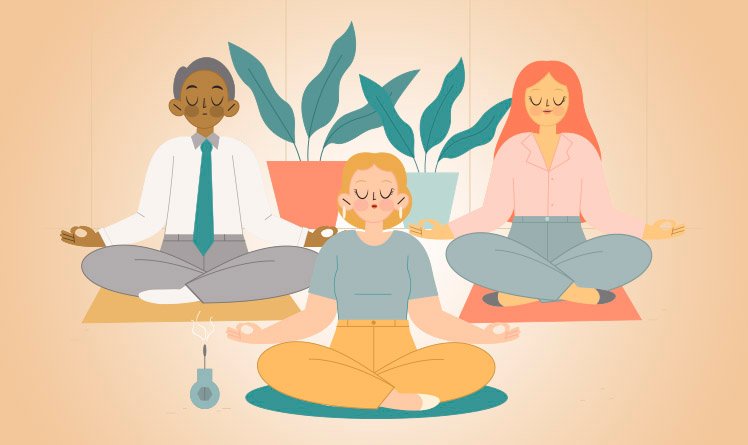How to Start Meditating: A Practical Guide for Beginners

|
Getting your Trinity Audio player ready...
|
Imagine waking up in the morning with clarity, lightness, and a quiet sense of presence. No more a thousand thoughts invading your mind before you even have breakfast. It's possible to live with more balance and purpose—and for many, it all starts with meditation.
If you feel you need more focus, less anxiety, and want to begin a journey of self-discovery, this guide is for you. We'll walk together, step by step, toward the practice of meditation, explaining everything in an accessible, practical, and scientifically based way.
Why Meditate? The Starting Point of the Inner Journey
Modern life demands too much: quick decisions, excessive stimuli, and little time for rest. So it's no wonder so many people are looking for ways to start meditating. After all, meditation is the conscious mind's counterattack against the automatic chaos of everyday life.
Furthermore, meditation isn't just relaxation. It's mental training. And like any training, it brings about structural changes in the brain—even proven by neuroscience studies, such as strengthening the prefrontal cortex region, responsible for focus and decision-making.
“Meditation is training the mind to get out of autopilot and enter presence mode.”
What is meditation, anyway? Definition, myths, and truths
Meditation is a mental and physical practice that seeks to guide the mind to a state of presence, clarity, or expanded consciousness. Therefore, depending on the technique, this can happen through mindfulness in the present moment (as in mindfulness), the repetition of mantras, creative visualization, the contemplation of ideas or emotions, or even spiritual surrender in devotional practices.
In other words, there's not just one way to meditate, nor a single goal. While some approaches aim for mindfulness in the present moment, others lead to ego transcendence, emotional purification, or a deepening connection with the sacred.
But one thing is certain: meditation is creating space within oneself. In other words, a space where thoughts don't dominate, but are observed. Where emotions don't take over, but are embraced. While the body isn't ignored, but rather perceived.
“Meditation is the cultivation of inner clarity, whether through silence, presence, or intention.”
Proven benefits of meditation for body and mind
Reduce stress and anxiety
Studies show that regular practice of meditation reduces cortisol levels, the stress hormone. It also activates the parasympathetic nervous system, responsible for rest and recovery.
Mental clarity and focus
Meditation improves concentration, working memory, and decision-making. It's like sharpening the axe before chopping down the tree: you get more done with less effort.
Emotional well-being and balance
By meditating, you develop self-awareness, emotional self-regulation, and empathy. It's no wonder that meditation is one of the most recommended practices in Positive Psychology for cultivating positive emotions and increasing well-being.
How to Start Meditating: First Steps for Beginners
Choosing the ideal environment
Find a quiet space where you feel safe. This could be your bedroom, a corner of the living room, or even your parked car. The important thing is that you can spend a few minutes there without interruptions.
Posture and breathing
Sit comfortably. This can be on the floor or in a chair. The key is to keep your spine straight but relaxed. Breathe consciously through your nose. Soon, your breath will be your anchor.
Practice time and frequency
Start with 3 to 5 minutes a day. Yes, that's all. Then gradually increase. The important thing is consistency. After all, meditating for 5 minutes every day is more effective than meditating for an hour once a month.
“To start meditating, all you need is a seated body, a curious mind, and some silence.”
Meditation techniques for beginners
Guided meditation
Ideal for beginners, you listen to instructions from a guide—which can be audio, an app, or a video—that guides your attention and helps you stay focused. Apps like Insight Timer, Meditopia, or Lojong are good free options.
Meditation mindfulness (mindfulness)
The most widespread technique today, which above all, consists of paying attention to the present moment, without judgment. This way, you can focus on your breathing, the sounds around you, or the sensations in your body. If your mind wanders, you simply notice—and come back.
Breathing-focused meditation
Simple and powerful. Sit back, close your eyes and watch your breathingFirst, feel the air coming in and out of your nostrils. However, when you realize you've gotten distracted, simply return to it. That's the practice.
Common difficulties at the beginning and how to overcome them without giving up
It's normal for your mind to wander, for itching, restlessness, and drowsiness to appear. None of this is a mistake. On the contrary, it's part of the process. So, the secret lies in not resist and not demand anything from yourselfJust gently come back to focus as often as you need to.
Another common obstacle is the expectation of "feeling something special." The practice is simple, but results come over time. Therefore, persistence is more important than intensity.
Integrating meditation into your daily life with ease
You can meditate while sitting, walking, or even washing dishes. Formal practice is important, but informal practice can also be transformative. So, try breathing mindfully for 1 minute before a meeting. Or observe your body while taking a shower. Meditation, especially when we're talking about meditation mindfulness, is present life.
“We don’t have to find time to meditate; we have to turn time into meditation.”
How Meditation Connects with Other Skills
Meditation strengthens mental skills such as focus, emotional regulation, and self-compassion—pillars of Positive Psychology. Similarly, NLP (Neuro-Linguistic Programming) uses mindfulness to access and reprogram mental patterns. Together, these approaches amplify your power to change.
Furthermore, cultivating the practice of meditation is a way of training a new mindset: more aware, resilient, and aligned with your goals. After all, a present mind makes wiser decisions.
What to avoid at the beginning of practice to avoid frustration
Avoid expecting immediate results. Above all, meditation is a process of cultivation, not a race. Also, avoid comparing yourself to others. After all, every mind has its own rhythm.
In this sense, don't turn meditation into just another obligation on your list. It should be a place to pause, not a time of pressure. Approach it with curiosity, without rushing. And remember: meditating poorly is still better than not meditating at all.
Conclusion: Your new beginning begins with a minute of silence
Meditation isn't a luxury. It's a necessity. You don't need special clothes, gurus, or trips to India. Quite the opposite. You just need a little willingness to be with yourself.
Start today. First, one minute. Then two. Then five. Soon, your mind will be clearer, your heart calmer, and your life lighter. You're not alone on this journey—and this article can be your first step toward a new state of being.
FAQ – Frequently asked questions about how to start meditating
1. What is the best time to meditate?
The best time to meditate is whenever you can maintain consistency. Many people prefer the morning, as it helps them focus throughout the day. Others, on the other hand, prefer the evening, to slow down. There's also nothing stopping you from meditating in the morning, upon waking, and before bed. Experiment and see what works best for you. After all, we are all unique beings with individual needs.
2. Do I need to sit on the floor to meditate?
No. You can meditate sitting in a chair, lying down, or even standing. The important thing is to maintain an upright posture and awake body.
3. How long does it take to see results?
Some people feel benefits after just a few days. Others take weeks. The important thing is regular practice, as the results are cumulative.
4. Can I meditate with music?
Yes, especially if it's instrumental, soft, and repetitive music. However, to develop internal focus, it's recommended to vary it with silent practices.
5. Can children learn to meditate?
Absolutely. There are techniques adapted for all ages. Meditation can help children with focus, sleep, anxiety, and emotional regulation.
Recommended reading:
Image: Freepik

Marcel Castilho is an expert in neuromarketing, neuroscience, mindfulness and positive psychology. In addition to being an advertiser, he also has a Master's degree in NLP – Neurolinguistic Programming. As the owner and founder of the communications agency VeroCom and also of the digital agency Vero Contents, he has been studying human behavior for over 30 years.



